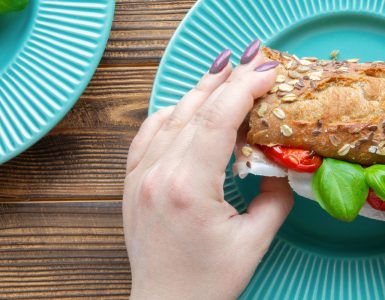Controlling your portions is necessary to eating healthy and managing your weight. In fact, how much you eat is just as important as what you’re eating. Eating too many calories from ANY food item can result in weight gain. Learning to control your portions can help you cut unnecessary calories from your diet.
Getting to Know Recommended Serving Sizes
- Beef, pork, or poultry: 3 ounces, about the size of a deck of playing cards
- Fish: 3 ounces, about the size of a checkbook
- One serving of fruit, veggies, pasta or rice is one cup, about the size of a baseball
- One serving of peanut butter or salad dressings is 2 tablespoons—about the size of a ping pong ball
- One serving of cheese is 1.5 ounces; that’s about the size of a domino
- The serving size of a potato is the size of a computer mouse.
Try some of these strategies to curb overeating:
- Use smaller plates and utensils to help you slow down your eating and reduce portion sizes.
- Start with a small serving and make sure you finish everything before you consider eating more.
- Place serving dishes away from the table to prevent automatically reaching for seconds.
- Take a break when you’re finished eating before going for more. This can let your brain catch up to your stomach. You may find you’re fuller than you think.
- Check the nutrition labels to see what size serving you really should be eating.
- Measure your food to ensure you’re eating the correct portion.
- Take special care to pre-portion your unhealthier foods to ensure you eat only one serving.
- Familiarize yourself with measuring spoons and cups so you can truly “eyeball” portions, or memorize visual cues.
- Avoid distracted eating. You’re almost guaranteed to overeat when you’re not focused on your food.
- Control your leftovers. Wrap up food immediately after you’re done eating to save for another time. If that’s still too challenging, only cook what you know you should eat.
Dining out can present a challenge because many restaurants serve oversize portions. Put these tips into practice next time you’re eating away from home:
- Split an entrée with a friend or family member.
- Bring home half your entrée to eat for another meal.
- Mind your meat. Restaurants often serve super-sized portions of meat. Check the ounces on the menu or ask your server. If it’s more than 3, you’ll know to not eat it all in one meal.
- Avoid buffets. It’s almost impossible to control your portions in an “all-you-can-eat” setting.
- Opt for a salad. Eating a salad prior to your meal can help to reduce the chance of overeating.
- Ask for dressing and sauces on the side. Instead of pouring the dressing over your food, just dip or use sparingly.
The most important tip for portion control is not to deny yourself. Indulge in the foods you really love, but do so in moderation. Allowing yourself to eat for pleasure some of the time may help to prevent binge eating and feelings of guilt that may lead to more eating.
For Health Advocate Members
Looking for additional nutrition information and support? If you’re a Health Advocate member with access to our Wellness Coaching rogram, call us today to connect with a coach for more healthy eating tips.




[…] skipping meals or not eating enough isn’t an effective or healthy strategy. Maintaining correct portions is also very important to healthy […]
[…] to practice good portion control during the big meal? This article and this articlecan both provide some helpful […]
[…] Need a primer on portion control? We’ve got you covered. […]